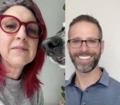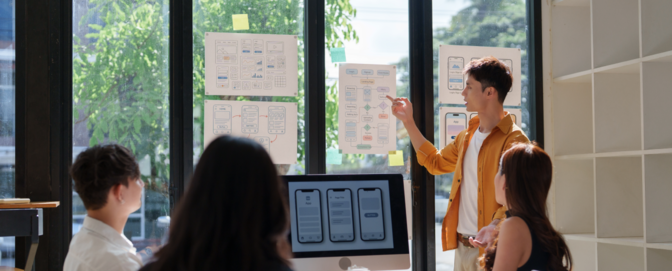
What is 3-D research? A UX Strategist and Research Leader at PwC discuss

UX Unfiltered is our series where we hear from UX, CX, design, and research professionals on tools for success at top organizations and their real-life examples to inspire your teams. Below, read our Q&A with PwC’s Nicole Norton, User Experience & Design Strategist, and Greg Smith, Human Experience and Research Leader, on the impact of 3-D research and making the most of siloed research teams.
1. Tell me a bit about your organization’s UX team. How long has the team done testing for feedback, and what sparked that? Has the process or attitudes changed over time?
Nicole/Greg: Our team is somewhat spread out across the organization these days, which has its strengths and drawbacks. The environment has evolved over the last three years, so each individual on our team sits within a separate part of the organization. It can be challenging to stay aligned, but it also provides us with several different perspectives—from internal stakeholders, users, and buyers—that help us clearly understand the various needs that must be met. So we see this position as a win.
Our team has been doing research since before we had a formal product group. There are pockets of User Experience work being done (and to varying degrees) throughout the organization, so there was awareness of the benefits of research and testing. Once we formally organized as a product team, research became a key focus area.
Over the last several years, there has been a lot of upskilling and education around the importance of putting our users at the center of our product experience. As a result, there has been a marked difference in that time in the amount of convincing that we need to do to justify why our work is essential to product development. Now we have different, more evolved challenges.
2. What’s a typical day like for you?
Nicole: The typical day is atypical. I am project-based, so I could be testing an application and interviewing a C-Suite executive about needs in the same day. It isn’t to say that this is atypical for research and testing but atypical within our corporate structure.
Greg: I tend to float between a mix of projects at any given time, some of which are more tactical in nature (i.e., concept testing on a mature product) and some of which are a bit more strategic (i.e., market validation research around a particular problem space). Any given week will entail at least a handful of user interviews and tests.
3. How would you define 3-D research?
Nicole: Because our team is spread throughout the product organization, we each have a slightly different perspective on the product experience. We work really well together, so, despite the fact that we sit on different teams, we continue to work together on each other’s projects. This leads us to the concept of 3-D Research—which we affectionately refer to as our “three-legged stool” of knowledge. We each view the product through a different lens (how the product is used, how the product is marketed and sold, and how the product is supported). Altogether, this gives us the most holistic picture of a product and puts us in a great position to provide powerful user insights.
Greg: As researchers, we always want to advocate for the users’ needs. However, to be successful as a product organization, that’s not the only perspective that needs to be factored in.
Buyers of a B2B product are often very different from the users of that product, so unless you understand what’s important to those individuals as well, you won’t be successful in your sales and marketing efforts.
And, of course, the business needs have to be factored in. A great product that doesn’t meet the needs of the teams that will ultimately need to support it is also not likely to succeed. So by having a clear understanding of each of those user groups and what’s important to them, we put our product teams in a position to be successful.
4. Can you expand upon the lessons you’ve learned in taking siloed research teams into a 3-D research model?
Nicole: We learned very quickly that each of the siloed teams had very different goals, and so we were often speaking three different languages. This ability to collaborate on each other’s projects gave us the perspective to have a better understanding of where each team was coming from. We were also able to share insights seamlessly across teams. An example of this was seen in an interview we did with a target buyer. This conversation gave us valuable information for our sales team about what the buyer wanted to experience in a demo. They also went into great detail about their internal procurement process, which was highly valuable information for our support team.
This joy of working together as this “unofficial” team has become an advantage for our strategy team to build a stronger stool (get it?).
Greg: The primary lesson for me has been the importance of continuous communication. Having people embedded in disparate parts of the organization gives us great insights into the key personas we need to solve for, but only if we have a way to consistently and efficiently share those insights with one another and build upon them. Figuring out how to surface the most relevant information at the right times and in the right way has been critically important to our success.
5. What are the benefits and drawbacks of a siloed approach to research, and how can teams mitigate them?
Nicole: The benefits of the siloed approach are the deep expertise in a particular product. You need to know the product and its user inside and out. The drawbacks are that you can’t see the shared pain points across the product suite or fully appreciate the product’s lifecycle (if your marketing or support teams are part of siloed structures as well).
Being a large organization, we have the benefit of having both, which only makes each of these approaches stronger. We can work with the product experts as well as share the cross-product and market data that we collect.
We have found to mitigate the cons of silos, you really have to make an effort to connect. We have done this in two ways. The first method is that our team organically works together on our cross-team projects, and the second is that we have a “watercooler” meeting open to all UX professionals. We use this time to share projects, resources, and challenges we are running into. It takes time, but well worth the effort.
6. What are the benefits of reaching across the discipline divide?
Nicole: The best example I can give in answer to this question is to tell you some of the benefits I get from our monthly “watercooler” talk. Some of the benefits are:
- Networking: I know more people that I feel comfortable reaching out to individually to ask questions or dig deeper into what they’re working on.
- Tools and resources: I can’t read every article or understand every product or service out there that helps me do my work. I love that I learn something new from each person on that call.
- Power in numbers: I don’t feel like it’s always an uphill battle to get our work done. I am not the only one that is dealing with the challenges that come to us.
Greg: Given the fundamentally different nature of the research we’re all doing, I find a great deal of value in learning about not just the insights that my peers are learning along the way but the methods that they’re using to gather those insights. It’s great to learn from one another in terms of best practices, new techniques, etc. It keeps things interesting and allows us each to continually hone our skills.
7. What does user feedback mean to you, your team, or your work?
Nicole: User feedback has changed the way I view everything. It has affected me just as much personally as it has professionally. Listening is not exactly the highest-praised skill in business (although I think it is getting more recognition). But knowing that I get paid to do something that I enjoy, that makes our products better and gives our people deeper insights into the problems that need solving, is highly satisfying.
Greg: I can’t overstate the value of user feedback. In an organization like ours, a lot of value is placed on ‘knowing the answer’ to a particular problem. That can, unfortunately, lead to situations where people put forth an unvalidated opinion and treat it as THE solution.
Helping teams to shift away from this ‘knowing’ mindset, to one in which they’re instead open to ‘discovering’ is really transformative.
I’ve seen teams create truly innovative solutions to really complex problems by simply taking the time to step back and learn from their customers.
Parts of this Q&A have been edited and condensed for clarity.

Watch a demo
See how easy it is to get fast feedback on a website, prototype, design, or more in this demo.





